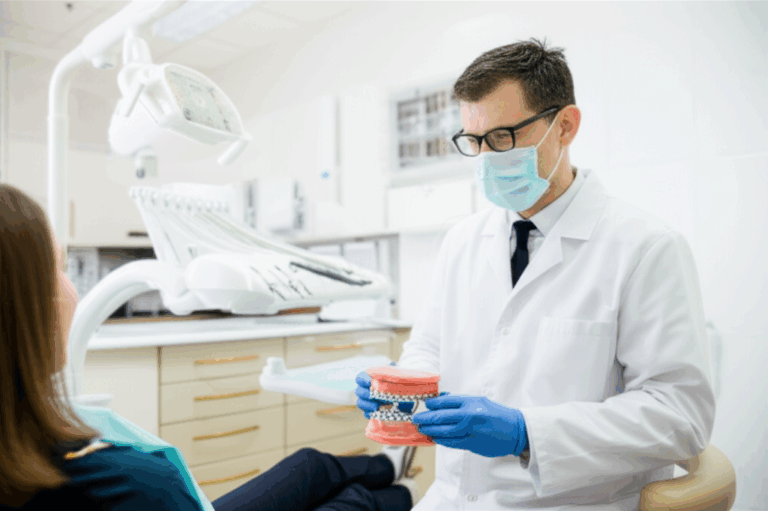
Why Do Dentists “Push” Crowns? The Real Story Behind Dental Crowns and Your Smile
Have you ever walked into the dentist’s office for a routine checkup and walked out with what felt like a major project in your mouth? Suddenly, you’re told you need a dental crown—and maybe you can’t help but wonder, “Do I really need this? Why do dentists seem to push crowns so much?” That doubt is more common than you might think. The truth is, this is a fair question, especially with the cost and the fact that getting a crown is a permanent choice.
Let’s explain why dentists recommend crowns, when you actually need one, what other options exist, and how you can make good choices about your dental health. We’ll keep things clear, simple, and honest—no confusing dental words that leave you scratching your head.
In This Article
- Understanding Why This Question Comes Up
- Dental Crowns Explained: What Are They and When Are They Needed?
- The Main Reasons Dentists Recommend Crowns (and Not Just for Money)
- What Alternatives Do You Have?
- Crowns vs. Other Options: Cost, Results, and How Long They Last
- Are Crowns Sometimes Over-Recommended? A Look at the Critique
- How to Have a Strong Conversation With Your Dentist
- Should You Get a Second Opinion?
- Top Questions to Ask Before Getting a Crown
- The Bottom Line: Crowns, Confidence, and Your Teeth
Understanding Why This Question Comes Up
Let’s be honest—dental work isn’t cheap, and nobody wants to pay for a treatment that isn’t needed. It doesn’t help that dental insurance often only covers part of the cost, leaving you with a big bill. So, when your dentist says you need a crown—especially when you didn’t expect it—it’s natural to wonder if it’s really about your tooth.
Here’s the truth: Dental crowns are one of the most common treatments in dentistry. They are routine, yes, but not always as “pushy” as it may seem. There’s a balance between dental health, long-term function, cost, and sometimes, yes, the needs of a dental office. It pays to see the whole picture before you decide.
Let’s start with the basics.
Dental Crowns Explained: What Are They and When Are They Needed?
Think of a dental crown as a custom “helmet” or “cap” for a hurt tooth. When your tooth is cracked, weak, worn down, or at risk of breaking, a crown covers and protects what’s left. It repairs the shape and lets you chew again—kind of like putting a cast on a broken arm, but for your tooth.
Crowns can be made from different materials—including ceramic, porcelain, gold, zirconia, or metal mixes. Each has its good points:
- Porcelain/Ceramic Crowns: Look just like real teeth; best for front teeth.
- Zirconia Crowns: Super strong, white, and last a long time.
- Gold or Metal Crowns: Very tough and less likely to break, but don’t look like natural teeth.
So, when do you really need a crown? Let’s break it down.
The Main Reasons Dentists Recommend Crowns (and Not Just for Money)
1. Big Tooth Decay
When a cavity (a hole in the tooth) gets too big for a simple filling, there isn’t enough strong tooth to hold a filling. A crown covers and protects what’s left so you don’t lose the tooth.
What if you leave it? The tooth can break, needing more difficult and costly treatments—like removing the tooth and getting an implant or bridge.
2. Cracked or Broken Teeth
A small crack might not sound serious, but it’s like a crack in an eggshell—one bite could split the tooth. Crowns hold the pieces together, seal the crack, and keep germs from getting inside and causing infection.
3. After Root Canal Work
A root canal saves a tooth by removing infected pulp inside. But, once the inside part is gone, the tooth becomes weak, like a dry twig. A crown protects it from breaking.
4. Big or Failing Fillings
Fillings wear out over time. If a filling is too big or is breaking down (cracks around it, new decay), a crown may be the only way to keep the tooth healthy.
5. Worn Down Teeth
Years of teeth grinding or acid wearing down teeth can flatten them, hurting your bite. Crowns rebuild the tooth’s height and let you chew again.
6. Looks and Function
Sometimes, teeth are so stained, shaped weirdly, or out of line that whitening, bonding, or veneers just won’t work. Here, a crown gives both the strength and look you want.
For more on how crowns are made, you can check out [crown and bridge lab] services.
What Alternatives Do You Have?
You might wonder, “Do I really have to get a crown?” The short answer: not always. Depending on your tooth, there could be other options:
Fillings
For small problems, a filling is usually the first choice. Think of a filling as a patch on a small hole—you wouldn’t fix the whole wall if only a small part is broken.
- Pros: Fast, cheaper, keeps more of your natural tooth.
- Cons: Not good for big or weak teeth. Doesn’t last as long on big repairs.
Onlays and Inlays (Partial Crowns)
These are custom pieces that fix a damaged part of the tooth, not the whole thing.
- Best for: Medium damage, when most of the tooth is fine.
- Downside: Not possible if too much tooth is missing.
Veneers
Thin covers for the front of teeth, best for small changes to healthy teeth.
- Not good for teeth with cracks, deep decay, or big fillings—veneers aren’t strong enough for weak teeth.
Tooth Removal and Replacement
When a tooth is “too far gone”—broken below the gum, with bad decay, or failed work—sometimes removal is the only choice. Then, you may think about:
- Dental implant: An artificial root with a crown on top.
- Bridge: A fake tooth attached to nearby teeth.
- Removable denture: For several missing teeth.
But, taking out and replacing a tooth is usually harder, takes longer, and costs more than saving it with a crown.
Crowns vs. Other Options: Cost, Results, and How Long They Last
Let’s talk about the price and what you get.
Cost: “Why So Expensive?”
- The average crown costs $1,000–$3,000 per tooth in the United States.
- The price depends on the material, lab work, dentist’s experience, and where you live.
- Insurance often covers about half, but only after your deductible.
Compare this to some other choices:
- Big composite filling: $150–$500 (but usually won’t last as long as a crown for a weak tooth)
- Extraction: $150–$500 (but now you need something to fill the gap!)
- Dental implant (after extraction): $3,000–$6,000 (plus months of healing)
- Bridge: $2,000–$5,000, could affect healthy nearby teeth
How Long These Last
| Restoration | Avg. Lifespan | Typical Success at 10 Years |
|---|---|---|
| Dental Crown | 10–15+ years | 90–95% |
| Big Filling | 3–8 years | 60–70% |
| Inlay/Onlay | 7–10 years | 80–90% |
Crowns usually give the longest-lasting results for badly damaged teeth.
Real-World Example
Samantha’s back tooth broke down after years of deep fillings. She chose to redo the filling instead of getting a crown. Two years later, the tooth broke below the gum. She needed an extraction, and her path to an implant was longer and more expensive.
Are Crowns Sometimes Over-Recommended? A Look at the Critique
Let’s be real—no job is free from bias or outside pressures, even dentistry.
The Skeptic’s View
- Crowns are a big source of money for dental offices
- Some people feel rushed into treatment without enough time or choices
- “One-size-fits-all” advice can make you wonder if less would have worked
The Professional Standards Side
Good dentists follow rules set out by the American Dental Association (ADA) and use evidence and your personal situation. Most want to keep your natural teeth as long as possible.
But how do you know if a crown is really needed or if it’s just “good for business?”
How to Have a Strong Conversation With Your Dentist
You have every right to ask questions and get clear answers. A good dentist will welcome your questions and explain your choices. Try these questions:
- Ask to see X-rays or photos, and have them show you the problem.
- Ask about fillings, onlays, or if just watching the tooth is okay.
- Some small issues can wait. Others can get worse quickly, causing more pain and cost.
- Knowing how long it’s expected to work helps you plan.
Remember, real informed consent means you know why a treatment is needed, and the pros and cons.
Should You Get a Second Opinion?
If you feel unsure or rushed, a second opinion is smart—especially for expensive, permanent, or complex dental work. This is normal and good dentists will not mind.
What to bring:
- Your X-rays and plan from the first dentist
- A list of your questions
Compare not just the treatments but the reasons given for each.
Top Questions to Ask Before Getting a Crown
- Can my tooth be fixed with a big filling or onlay, or do I need a full crown?
- What type of crown will you use, and why?
- Will the crown affect my bite or how I look?
- What steps are there in getting the crown? (Many offices work with a [digital dental lab] to make custom crowns.)
- How do I take care of the crown to make it last?
Who Is a Good Candidate for a Crown?
Crowns are best if:
- The tooth is badly broken, cracked, or decayed, but the root is healthy.
- You just had a root canal on a back tooth.
- You have big, old fillings that keep failing.
- Tooth wear or decay has left only a little natural tooth above the gum.
If you have bad gum disease, lots of cavities, or a broken root, a crown may not work. In those cases, there are other treatments.
Your Healthy Takeaway: What You Should Remember
Let’s sum up:
- Dental crowns are not a “scam.” Most of the time, they really help save teeth and stop worse (and more expensive) problems later.
- Not every tooth needs a crown. Fillings, onlays, and veneers also have their place—ask about them.
- The “push” for crowns often comes from wanting to give long-term fixes—but you should always get a clear answer.
- Always ask questions and get a second opinion if you’re unsure.
- Prevention is best. Brushing, flossing, routine checkups, and fixing small problems early means you may avoid needing a crown.
Your Simple Dental Action Plan
- Get regular dental exams and fix small issues early.
- Ask the dentist to show you X-rays/photos whenever a crown is recommended.
- Compare how long each option lasts and any risks—not just cost.
- Pick a trusted provider. It’s okay to ask about their experience—look for practices working with a solid [crown and bridge lab] or using a modern [digital dental lab].
- Keep up good home care. Brushing and flossing are your best friends to avoid major dental work!
Want to know how top crowns are made? Check out info on [dental ceramics lab] materials and processes.
A Friendlier Way Forward
Crowns can feel scary, but at their core, they’re a way to keep your smile healthy and strong. If you feel pressured, confused, or left out, remember: this is your mouth and your body. The best result always comes from working together—with understanding, open talk, and respect.
Your questions matter. The more you know, the more confident you’ll feel when making choices for your teeth.
Quick Reference: Pros and Cons of Crowns
| Pros | Cons |
|---|---|
| Strong, lasting fix for weak teeth | Upfront cost can be high |
| Restores look and chewing | Needs more tooth taken away |
| Stops more serious tooth problems | Not reversible—once done, always there |
| Can match your real tooth color | Might need replacing someday |
| Tough materials (porcelain, zirconia, gold) | Often needs more than one visit |
Sources & Trust Points
- American Dental Association: Dental Crowns
- Medically checked by a licensed dentist or hygienist
You Asked, You Learned, Now You’re Empowered
Crowns can be a “big fix”—but if recommended for the right reasons, they’re often the best way to save your tooth and wallet for the future. If you’re ever unsure, ask, read up, and remember—you’re not just a patient, you’re a partner in your dental care.
Stay curious. Stay proactive. And keep smiling!
This info is general. For advice about your teeth, always talk to a qualified dentist.
Internal Links Used in This Guide
- [crown and bridge lab]: For info on how custom crowns are made and why lab quality matters.
- [digital dental lab]: See how technology helps with making modern crowns.
- [dental ceramics lab]: Learn about high-quality materials and processes for great crowns.
If you want a helpful, patient-focused guide, check out our [patient dental] hub.
Ready to make confident choices? Bring your questions to your next visit, and turn dental worries into smart, healthy choices for your smile.








